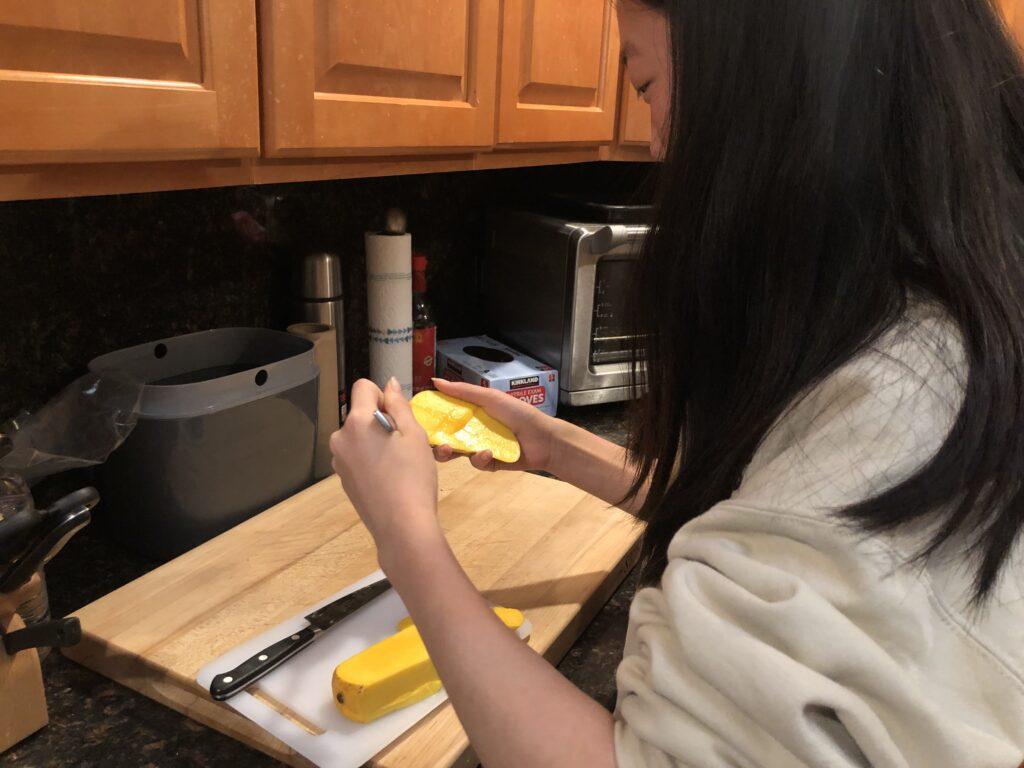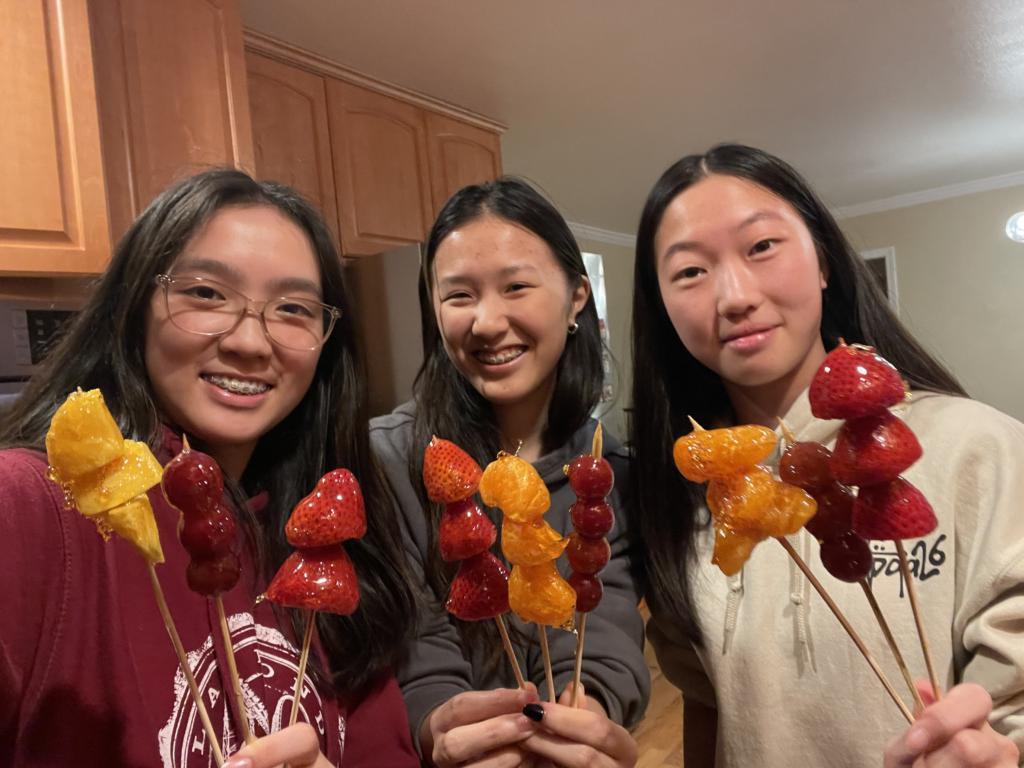In the past year, tanghulu, a sugary treat that originated in northern China and is made up of a hard sugar shell that coats fruits, has taken social media by storm in the past half year.
Videos of people trying it at street food stalls or attempting to make it at home have gained millions of views, enticing others to try the sugary creation out too.
During the Song Dynasty lasting from 960 to 1279, the royal family believed that eating tanghulu for two weeks healed the emperor’s favorite concubine. Tanghulu was recently repopularized by Korean street food and social media influencers who make viral ASMR videos. To join in the fun, we decided to try making it at home.
After telling all our parents we were working on an “important journalism project” (a reasonable excuse to meet on a school day just to eat sweets), Shirina and Amy met at Emily’s house. Unfortunately, Jessica couldn’t make it, but we brought her some tanghulu afterward so she could provide her ratings.
For the fruit options, Shirina brought mangos, kiwis, strawberries and oranges; Amy brought oranges, lemons and grapes and Emily provided cooking utensils and equipment. Lemons might seem like an odd choice, but who knows? Maybe a thick coat of sugar could make even a slice of lemon taste good.
A few days prior, Jessica had tried to make tanghulu herself out of boredom. She consulted her saved videos in TikTok, jotting down tips such as drying the fruit completely and using a toothpick to test the consistency of the sugar. However, she turned the heat too high in hopes that it would save time, not realizing it would end in a catastrophe. The sugar turned black before she even finished skewering the fruit and ended in a huge failure. If anyone has a liking for burnt sugar, we recommend consulting Jessica for failed tanghulu samples.
Following FeedMi’s online recipe, the three of us prepared the fruits by washing, cutting and skewering three of them on a stick to make a rainbow of skewers. We were excited to have multiple colors, but when we cut open the kiwi, the smell of slightly overripe, but not-yet-rotten kiwi filled the kitchen as we peeled off the skin and sliced it into cubes. The mushy kiwi slid easily onto the skewer, but immediately slid down the stick and plopped back onto the cutting board. For those of you who are looking to try making this treat for yourselves, make sure that the fruits you choose aren’t overripe to avoid the mess we created.

Photo by Emily Wu
Amy cuts and scoops out the flesh of a mango to prepare it for skewering.
Next came time to heat the sugar on the stove. Looking back, it took around 30 minutes for the sugar to reach the desired temperature of 300 degrees Fahrenheit, so in hindsight, we should have started heating the sugar while we were preparing the skewers. With a handy dandy thermometer, we heated two parts sugar and one part water on medium heat. Cautious not to burn the sugar the way Jessica had, we obsessively checked the temperature every few seconds until it finally read 300.
This was when the fun began. One by one, we stood hovering around the stove, tilting the pot and swirling each skewer until it was covered in a warm, gooey sugar mixture. To ensure that the sugar would harden quickly to form a crunchy coat, we quickly pulled the skewer out of the pot and placed it into an ice bath prepared on the side. After waiting for the sugar to completely harden, we took the skewer out of the ice bath and placed it onto a plate.
At first, the sugar was slightly short of the desired 300 degrees, so it didn’t harden immediately when dunked into the ice bath. This left it with a small tail that felt like a sharp shard of glass in our mouths. But after a few tries, we got the hang of it, and the tanghulu looked more Instagram-worthy.

Photo by Amy Miao
Our finished product, easy on the eyes and crunchy in the mouth.
However, this meticulous process was short-lived as we noticed the light yellow sugar mixture was darkening at an alarming rate. Chaos ensued as we darted from the skewers to the pot, attempting to dip all of the fruit in before the sugar burned completely. As painfully inexperienced dessert chefs, we dripped sugar water all over the floor and even overtilted the pot, spilling a large glob of boiling hot sugar onto the electric stove. The sugar sizzled loudly and turned into a hard black lump within a matter of seconds, and as we frantically began scrubbing the floor and stove with cleaning alcohol, our socks got stuck to the floor, filling the kitchen with laughter.
Shirina snacked on a tanghulu made from the golden-brown sugar and gave a cheeky smile; the sugar tasted “toasty,” like when a marshmallow gets slightly over-roasted.
Despite our sticky mishaps, making tanghulu was an entertaining experience that also gave us an excuse to meet on a school afternoon just to make and eat sweets. Here’s what we thought about each fruit:
Strawberries — 9/10 Falcons: as the most popular fruit for tanghulu besides hawthorn berries, strawberries did not disappoint. The flavor balance between fruit and sugar was “chef’s kiss” and the texture was amazing. Each bite was perfectly paired with crunchy sugar and firm fruit.
Grapes — 7/10 Falcons: The most aesthetic of the group, the grape tanghulu were the easiest to dip. However, the combination of naturally sweet grapes with even more sugar made the sweetness overwhelming.
Mangos — 6/10 Falcons: The mango we used was not fully ripe, so it was slightly sour and bitter, spoiling this high-potential fruit. Preparing it was also time-consuming as we had to carefully cut around the large mango seed, slice the remaining flesh into small cubes and then spoon out the cubes with a large spoon. The amount of preparation was not worth the ho-hum result.
Oranges — 5.5/10 Falcons: The tartness of the orange paired well with the sugar, but the juices caused the sugar coating to fall off after the first bite.
Lemon — 4.5/10 Falcons: we tried this partially as a joke, but it actually surpassed our (low) expectations! The sugar coating masked some of the lemon’s sourness to make it more bearable. Amy and Emily each managed to eat an entire slice.
Kiwi — 4/10 Falcons: The pretty green color gave us false hope that it would taste good, but the kiwi we used was mushy and completely fell apart in our mouths when we bit down. With firmer kiwis, however, it could have made a delectable treat!



























